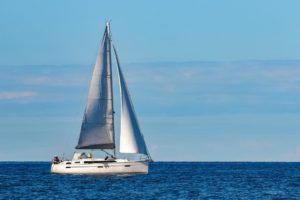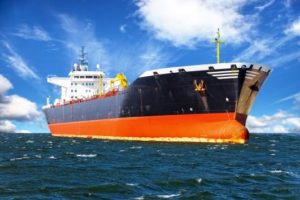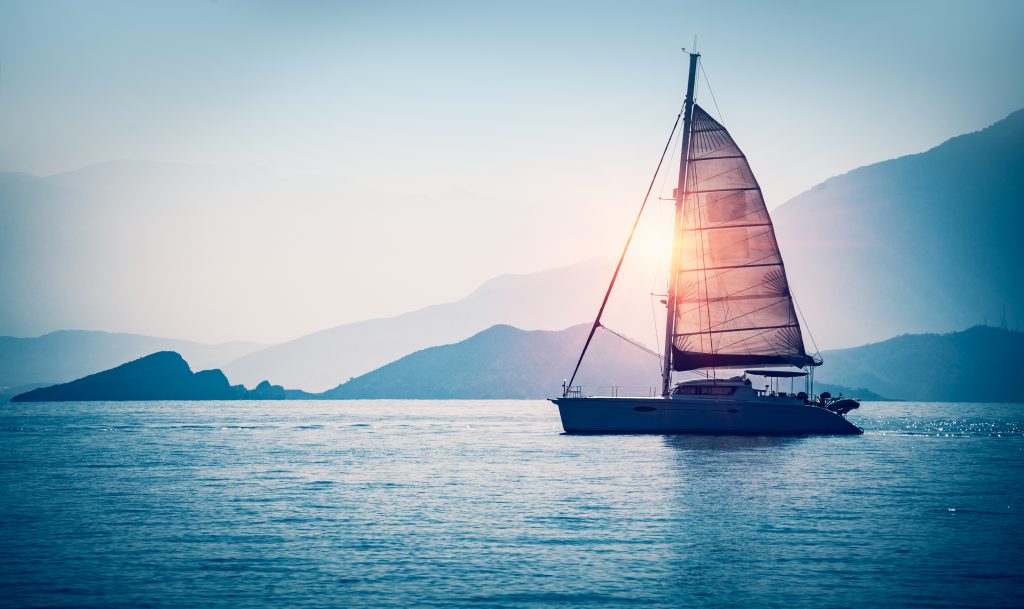This lesson focuses on watercraft engineering and sailing. Students work in teams to design a sailboat that can carry a set load across water for 1 meter.
- Learn about marine engineering and sailing principles.
- Learn about engineering product planning and design.
- Learn about meeting the needs of society.
- Learn about teamwork and working in groups.
Age Levels: 8-18
Materials & Preparation
Build Materials (For each team)
Required Materials (Trading/Table of Possibilities)
- Empty wax coated milk or juice cartons
- Empty water bottles with lids
- Paper
- Cardboard
- Glue
- String
- Aluminum foil
- Plastic wrap
- Fabric
- Balloons
- Toothpicks
- Popsicle sticks
- Rubber bands
- Wire
Testing Materials
- Standard weight (several coins of same denomination or small plastic container filled with sand, gravel, aquarium stones, etc.)
- Water
- Water trough, shallow long container, or child’s pool (minimum 1 meter in length)
- Hair dryer or small fan with multiple speeds
- Measuring tape
Testing Materials & Process
Materials
- Standard weight (several coins of same denomination or small plastic container filled with sand, gravel, aquarium stones, etc.)
- Water
- Water trough, shallow long container, or child’s pool (minimum 1 meter in length)
- Hair dryer or small fan with multiple speeds
- Measuring tape
Process
Pre-fill the water trough with enough water to allow for boats to float. Mark a starting point to place each team’s boat for consistency.
Test each team’s boat design by placing the set weight on the boat and placing the boat in the water trough at the starting point. Direct the hair dryer/fan toward the sail of the boat. Set the hair dryer/fan at the same speed for all tests and hold it the same distance from each boat. Team’s should measure and document how far their boat traveled before stopping or sinking.
Engineering Design Challenge
Design Challenge
You are a team of marine engineers given the challenge of designing a sailboat that can hold a set weight while sailing 1 meter across a classroom waterway harnessing wind energy from a fan.
Criteria
- Design must hold a set weight (determined by teacher).
- Must move 1 meter along a classroom waterway, with the power of a hair dryer/fan
Constraints
- Use only the materials provided.
- Teams may trade unlimited materials.
Activity Instructions & Procedures
- Break class into teams of 2-3.
- Hand out the Sail Away worksheet, as well as some sheets of paper for sketching designs.
- Discuss the topics in the Background Concepts Section. Ask students to think about how the weight their boat must carry should be distributed in the boat for stability during motion. They should also think about what their sail material will be and how it will be attached to the boat.
If time allows, review physics of sailing and sailing simulators using:
● WB-Sails DynaSim http://www.wb-sails.fi/en/sail-technology/dynasim
● The Physics of Sailing http://newt.phys.unsw.edu.au/~jw/sailing.html - Review the Engineering Design Process, Design Challenge, Criteria, Constraints and Materials.
- Provide each team with their materials.
- Explain that students must design and build a boat. The boat must hold a set weight while sailing 1 meter across a classroom waterway using wind energy from a hair dryer or fan.
- Announce the amount of time they have to design and build (1 hour recommended).
- Use a timer or an on-line stopwatch (count down feature) to ensure you keep on time. (www.online-stopwatch.com/full-screen-stopwatch). Give students regular “time checks” so they stay on task. If they are struggling, ask questions that will lead them to a solution quicker.
- Students meet and develop a plan for their boat. They agree on materials they will need, write/draw their plan, and present their plan to the class. Teams may trade unlimited materials with other teams to develop their ideal parts list.
- Teams build their designs.
- Pre-fill the water trough with enough water to allow for boats to float. Mark a starting point to place each team’s boat for consistency.
Test each team’s boat design by placing the set weight on the boat and placing the boat in the water trough at the starting point. Direct the hair dryer/fan toward the sail of the boat. Set the hair dryer/fan at the same speed for all tests and hold it the same distance from each boat. Team’s should measure and document how far their boat traveled before stopping or sinking. - Teams should document the distance their boat traveled before stopping or sinking.
- As a class, discuss the student reflection questions.
- For more content on the topic, see the “Digging Deeper” section.
Re-design Idea
Consider having enough materials to allow students to redesign their boat after the first test and comparing results between their two designs.
Student Reflection (engineering notebook)
- Were you able to create a boat that could hold weight, catch the wind, and travel one meter?
- If yes, did you need to rework your boat during the testing process? What did you need to change about your boat to make it meet the challenge?
- Do you think your design could scale upward and work as a full size sailboat? Why or why not?
- What aspects of other team’s boats did you find interesting? Were there aspects of other designs you wish you had incorporated into your own team’s boat?
- How different were all the final boats? What did that tell you about problem solving?
- If you had a chance to do this project again, what would your team have done differently?
- Do you think you would have been able to create a successful boat if you had not been working in a group? What did the group interaction add to the design and problem solving process?
Time Modification
The lesson can be done in as little as 1 class period for older students. However, to help students from feeling rushed and to ensure student success (especially for younger students), split the lesson into two periods giving students more time to brainstorm, test ideas and finalize their design. Conduct the testing and debrief in the next class period.
Engineering Design Process
Background Concepts
Marine Engineering, Sailing, and Physics

New-SIGHT-Photography-bigstock.com
What is Sailing?
Sailing is the skillful art of controlling the motion of a sailing ship or sailboat, across a body of water. The force of the wind on the sails propels sailing vessels. Today, for most people, sailing is recreation, an activity pursued for the joy of being on the water and pursuing the mastery of skills needed to maneuver a sailboat in varying sea and wind conditions. Throughout history sailing has been instrumental in the development of civilization. The earliest representation of a ship under sail appears on an Egyptian vase from about 3500 BC.
Sail Aerodynamics
Sails propel the boat in one of two ways. When the boat is going in the direction of the wind (i.e. downwind), the sails may be set merely to trap the air as it flows by. Sails acting in this way are aerodynamically stalled. In stronger winds, turbulence created behind stalled sails can lead to aerodynamic instability, which in turn can manifest as increased downwind rolling of the boat. Spinnakers and square rigged sails are often trimmed so that their upper edges become leading edges and they operate as airfoils again, but with airflow directed more or less vertically downwards. This mode of trim also provides the boat with some actual lift and may reduce both wetted area and the risk of ‘digging in’ to waves. The other way sails propel the boat occurs when the boat is traveling across or into the wind. In these situations, the sails propel the boat by redirecting the wind coming in from the side towards the rear. In accordance with the law of conservation of momentum, air is redirected backwards, making the boat go forward. This driving force is called lift although it acts largely horizontally. The lift generated by a sail can be resolved into two main components; forward force and sideways force. These forces act against opposing forces generated by the hull and the keel. On a sailing boat, a keel or centerboard helps to prevent the boat from moving sideways. The shape of the keel has a much smaller cross section in the fore and aft axis and a much larger cross section on the athwart axis (across the beam of the boat). The resistance to motion along the smallest cross section is low while resistance to motion across the large cross section is high, so the boat moves forward rather than sideways.

Nightman1965-bigstock.com
Marine Engineers and Naval Architects
Marine engineers and naval architects are involved in the design, construction, and maintenance of ships, boats, and related equipment. They design and supervise the construction of everything from aircraft carriers to submarines, and from sailboats to tankers. Naval architects work on the basic design of ships, including hull form and stability. Marine engineers work on the propulsion, steering, and other systems of ships. Marine engineers and naval architects apply knowledge from a range of fields to the entire design and production process of all water vehicles.
Vocabulary
- Constraints: Limitations with material, time, size of team, etc.
- Criteria: Conditions that the design must satisfy like its overall size, etc.
- Engineers: Inventors and problem-solvers of the world. Twenty-five major specialties are recognized in engineering (see infographic).
- Engineering Design Process: Process engineers use to solve problems.
- Engineering Habits of Mind (EHM): Six unique ways that engineers think.
- Float: Rest or move on or near the surface of a liquid without sinking.
- Iteration: Test & redesign is one iteration. Repeat (multiple iterations).
- Load: A heavy or bulky thing that is being carried or is about to be carried.
- Marine Engineers and Naval Architects: Are involved in the design, construction, and maintenance of ships, boats, and related equipment.
- Prototype: A working model of the solution to be tested.
- Sailing: The skillful art of controlling the motion of a sailing ship or sailboat, across a body of water.
Dig Deeper
Internet Connections
Recommended Reading
- Introduction to Marine Engineering, Second Edition (ISBN: 0750625309)
- The Complete Sailor: Learning the Art of Sailing (ISBN: 0070571317)
- Toy boats, 1870-1955: A pictorial history (ISBN: 0684159678)
Writing Activity
Write an essay or a paragraph about how marine engineers have to incorporate the range of water temperatures across the globe when designing a cruise ship that will travel all around the world.
Curriculum Alignment
Alignment to Curriculum Frameworks
Note: Lesson plans in this series are aligned to one or more of the following sets of standards:
- U.S. Science Education Standards (http://www.nap.edu/catalog.php?record_id=4962)
- U.S. Next Generation Science Standards (http://www.nextgenscience.org/)
- International Technology Education Association’s Standards for Technological Literacy (http://www.iteea.org/TAA/PDFs/xstnd.pdf)
- U.S. National Council of Teachers of Mathematics’ Principles and Standards for School Mathematics (http://www.nctm.org/standards/content.aspx?id=16909)
- U.S. Common Core State Standards for Mathematics (http://www.corestandards.org/Math)
- Computer Science Teachers Association K-12 Computer Science Standards (http://csta.acm.org/Curriculum/sub/K12Standards.html)
National Science Education Standards Grades K-4 (ages 4 – 9)
CONTENT STANDARD A: Science as Inquiry
As a result of activities, all students should develop
- Abilities necessary to do scientific inquiry
CONTENT STANDARD B: Physical Science
As a result of the activities, all students should develop an understanding of
- Properties of objects and materials
- Position and motion of objects
CONTENT STANDARD E: Science and Technology
As a result of activities, all students should develop
- Abilities of technological design
- Understanding about science and technology
CONTENT STANDARD F: Science in Personal and Social Perspectives
As a result of activities, all students should develop understanding of
- Science and technology in local challenges
CONTENT STANDARD G: History and Nature of Science
As a result of activities, all students should develop understanding of
- Science as a human endeavor
National Science Education Standards Grades 5-8 (ages 10 – 14)
CONTENT STANDARD A: Science as Inquiry
As a result of activities, all students should develop
- Abilities necessary to do scientific inquiry
CONTENT STANDARD B: Physical Science
As a result of their activities, all students should develop an understanding of
- Motions and forces
- Transfer of energy
CONTENT STANDARD E: Science and Technology
As a result of activities in grades 5-8, all students should develop
- Abilities of technological design
- Understandings about science and technology
CONTENT STANDARD F: Science in Personal and Social Perspectives
As a result of activities, all students should develop understanding of
- Science and technology in society
National Science Education Standards Grades 9-12 (ages 14-18)
CONTENT STANDARD A: Science as Inquiry
As a result of activities, all students should develop
- Abilities necessary to do scientific inquiry
CONTENT STANDARD B: Physical Science
As a result of their activities, all students should develop understanding of
- Motions and forces
- Conservation of energy and increase in disorder
- Interactions of energy and matter
CONTENT STANDARD E: Science and Technology
As a result of activities, all students should develop
- Abilities of technological design
- Understandings about science and technology
CONTENT STANDARD F: Science in Personal and Social Perspectives
As a result of activities, all students should develop understanding of
- Natural and human-induced hazards
- Science and technology in local, national, and global challenges
Standards for Technological Literacy – All Ages
The Nature of Technology
- Standard 1: Students will develop an understanding of the characteristics and scope of technology.
- Standard 2: Students will develop an understanding of the core concepts of technology.
- Standard 3: Students will develop an understanding of the relationships among technologies and the connections between technology and other fields of study.
Technology and Society
- Standard 6: Students will develop an understanding of the role of society in the development and use of technology.
Design
- Standard 8: Students will develop an understanding of the attributes of design.
- Standard 9: Students will develop an understanding of engineering design.
- Standard 10: Students will develop an understanding of the role of troubleshooting, research and development, invention and innovation, and experimentation in problem solving.
Abilities for a Technological World
- Standard 11: Students will develop abilities to apply the design process.
The Designed World
- Standard 18: Students will develop an understanding of and be able to select and use transportation technologies.
- Standard 20: Students will develop an understanding of and be able to select and use construction technologies.
Related Engineering Fields and Degrees
Student Worksheet
Build Your Own Watercraft
Engineering Teamwork and Planning
You are a team of marine engineers given the challenge of designing a sailboat using everyday materials that can hold a set weight and move 4 feet along a classroom waterway harnessing wind energy from a fan.
Planning and Design Phase
Each team has been provided with a set of materials. Review these as a group and draw your plan for a boat design in the box below. Think about how the weight your boat must carry should be distributed in the boat for stability during motion. Also, think about what your sail material will be and how it will be attached to the boat securely.
Construction Phase
As a team, build your boat, and then complete the questions below:
- How similar was your design to the actual boat you built?
- If you found you needed to make changes during the construction phase, describe why you made revisions.
- Did you find you needed to add extra materials to your boat during the construction phase? If so, what parts did you need to add?
Testing Phase
Your teacher has created a waterway for testing your watercraft. Test your boat! If you find your sail or boat design doesn’t work the first time, you’ll have an opportunity to redesign your boat and try again. Don’t worry if it fails the first time. Part of engineering is testing and designing products until the optimal design is achieved.
Evaluation Phase
Answer the following questions to summarize your experience with the Sail Away activity. Work in teams to come up with group opinions.
- Were you able to create a boat that could hold weight, catch the wind, and travel four feet?
- If yes, did you need to rework your boat during the testing process? What did you need to change about your boat to make it meet the challenge?
- Do you think your design could scale upward and work as a full size sailboat? Why or why not?
- What aspects of other team’s boats did you find interesting? Where there aspects of other designs you wish you had incorporated into your own team’s boat?
- How different were all the final boats? What did that tell you about problem solving?
- If you had a chance to do this project again, what would your team have done differently?
- Do you think you would have been able to create a successful boat if you had not been working in a group? What did the group interaction add to the design and problem solving process?
Presentation
As a group, make a presentation to the class about what you learned during this activity.
Translations





 Industrial Engineering
Industrial Engineering
 Computer Engineering
Computer Engineering